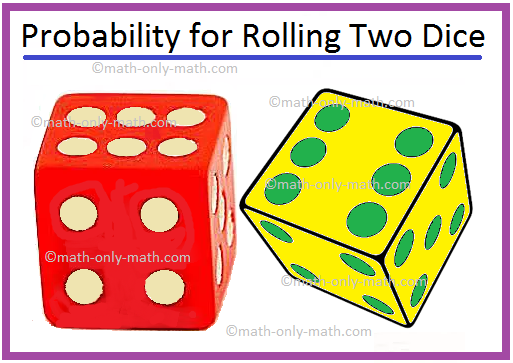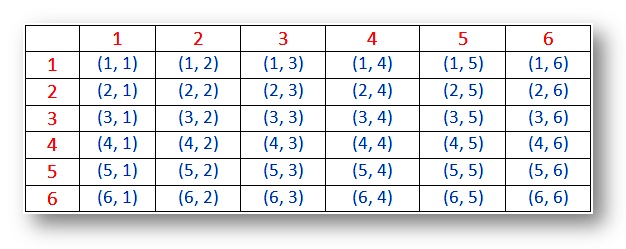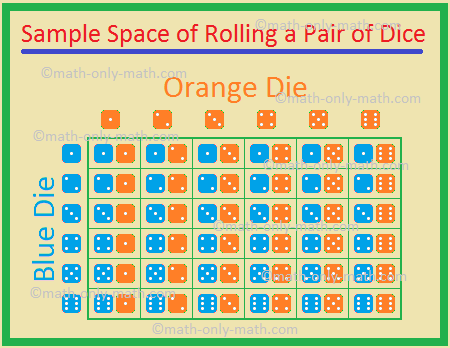Probability Of Rolling Two Dice
Probability for Rolling Ii Die
Probability for rolling two die with the six sided dots such as one, 2, 3, 4, 5 and 6 dots in each dice.

When two dice are thrown simultaneously, thus number of outcome can exist 6ii = 36 considering each die has 1 to 6 number on its faces. Then the possible outcomes are shown in the below tabular array.
Probability – Sample space for two dice (outcomes):

Note:
(i) The outcomes (1, 1), (2, two), (3, 3), (4, four), (5, 5) and (6, 6) are called doublets.
(ii) The pair (i, two) and (ii, 1) are unlike outcomes.
Worked-out issues involving probability for rolling two dice:
i. Ii dice are rolled. Let A, B, C exist the events of getting a sum of two, a sum of iii and a sum of iv respectively. Then, show that
(i) A is a unproblematic result
(two) B and C are compound events
(iii) A and B are mutually exclusive
Solution:
Conspicuously, nosotros have
A = {(1, one)}, B = {(one, 2), (two, i)} and C = {(ane, 3), (3, 1), (2, ii)}.
(i) Since A consists of a single sample indicate, it is a simple result.
(ii) Since both B and C contain more than one sample point, each one of them is a compound event.
(iii) Since A ∩ B = ∅, A and B are mutually exclusive.
ii. Two dice are rolled. A is the upshot that the sum of the numbers shown on the two die is 5, and B is the effect that at to the lowest degree one of the dice shows upwardly a 3.
Are the two events (i) mutually sectional, (2) exhaustive? Give arguments in support of your answer.
Solution:
When two dice are rolled, we have n(S) = (6 × 6) = 36.
At present, A = {(i, 4), (2, three), (4, one), (3, two)}, and
B = {(iii, i), (iii, 2), (3, three), (3, 4), (3, 5), (3, six), (i,three), (2, 3), (4, iii), (v, three), (6, 3)}
(i) A ∩ B = {(2, 3), (3, 2)} ≠ ∅.
Hence, A and B are non mutually exclusive.
(two) Also, A ∪ B ≠ Southward.
Therefore, A and B are not exhaustive events.
More examples related to the questions on the probabilities for throwing ii dice.
3. Ii dice are thrown simultaneously. Detect the probability of:
(i) getting half dozen as a production
(ii) getting sum ≤ iii
(iii) getting sum ≤ 10
(iv) getting a doublet
(5) getting a sum of viii
(vi) getting sum divisible by 5
(seven) getting sum of atleast 11
(eight) getting a multiple of 3 as the sum
(ix) getting a total of atleast 10
(10) getting an even number as the sum
(11) getting a prime as the sum
(xii) getting a doublet of even numbers
(13) getting a multiple of 2 on 1 die and a multiple of three on the other die
Solution:
Two dissimilar dice are thrown simultaneously beingness number 1, 2, 3, four, 5 and half-dozen on their faces. We know that in a single thrown of two dissimilar dice, the total number of possible outcomes is (6 × 6) = 36.
(i) getting six equally a product:
Let Due east1 = upshot of getting half dozen equally a product. The number whose product is six will be Eane = [(i, 6), (2, iii), (3, 2), (6, 1)] = four
Therefore, probability of getting 'six as a product'
Number of favorable outcomes
P(E1) = Total number of possible upshot
= iv/36
= ane/9
(ii) getting sum ≤ 3:
Permit Etwo = event of getting sum ≤ 3. The number whose sum ≤ 3 will exist E2 = [(1, 1), (1, two), (2, 1)] = iii
Therefore, probability of getting 'sum ≤ three'
Number of favorable outcomes
P(Due east2) = Total number of possible upshot
= iii/36
= 1/12
(iii) getting sum ≤ 10:
Let E3 = event of getting sum ≤ x. The number whose sum ≤ ten will exist Due east3 =
[(1, i), (1, two), (1, 3), (i, 4), (1, five), (one, six),
(2, ane), (2, 2), (2, 3), (ii, 4), (2, 5), (2, 6),
(3, one), (3, 2), (3, 3), (three, 4), (3, v), (3, vi),
(4, 1), (4, 2), (4, 3), (4, 4), (4, 5), (4, 6)
(five, 1), (5, 2), (5, 3), (5, four), (5, 5),
(6, 1), (6, 2), (half-dozen, 3), (six, 4)] = 33
Therefore, probability of getting 'sum ≤ ten'
Number of favorable outcomes
P(Due eastthree) = Total number of possible result
= 33/36
= 11/12
(iv) getting a doublet: Allow Efour = event of getting a doublet. The number which doublet volition exist E4 = [(1, 1), (ii, 2), (3, 3), (4, 4), (5, v), (6, 6)] = half-dozen
Therefore, probability of getting 'a doublet'
Number of favorable outcomes
P(E4) = Total number of possible event
= half-dozen/36
= ane/6
(five) getting a sum of viii:
Permit E5 = outcome of getting a sum of eight. The number which is a sum of 8 will exist Ev = [(ii, six), (3, 5), (4, 4), (5, 3), (six, 2)] = 5
Therefore, probability of getting 'a sum of 8'
Number of favorable outcomes
P(East5) = Total number of possible outcome
= v/36
(half-dozen) getting sum divisible past 5:
Let Easthalf-dozen = issue of getting sum divisible past 5. The number whose sum divisible by 5 will be Due east6 = [(i, 4), (2, iii), (3, 2), (4, 1), (4, vi), (5, v), (vi, 4)] = vii
Therefore, probability of getting 'sum divisible past v'
Number of favorable outcomes
P(E6) = Total number of possible event
= 7/36
(vii) getting sum of atleast eleven:
Permit E7 = upshot of getting sum of atleast xi. The events of the sum of atleast eleven will be Due east7 = [(five, half-dozen), (half-dozen, v), (half dozen, six)] = three
Therefore, probability of getting 'sum of atleast 11'
Number of favorable outcomes
P(East7) = Total number of possible issue
= iii/36
= one/12
(eight) getting a multiple of three as the sum:
Let E8 = event of getting a multiple of 3 equally the sum. The events of a multiple of 3 every bit the sum will be E8 = [(1, 2), (1, five), (ii, one), (2, 4), (three, 3), (three, six), (4, 2), (4, 5), (five, 1), (v, 4), (6, iii) (6, 6)] = 12
Therefore, probability of getting 'a multiple of three as the sum'
Number of favorable outcomes
P(E8) = Total number of possible outcome
= 12/36
= 1/three
(ix) getting a total of atleast x:
Allow E9 = event of getting a total of atleast x. The events of a full of atleast ten volition be Eix = [(4, 6), (5, five), (five, 6), (vi, four), (6, 5), (six, 6)] = half dozen
Therefore, probability of getting 'a total of atleast 10'
Number of favorable outcomes
P(E9) = Total number of possible outcome
= six/36
= 1/half-dozen
(10) getting an even number equally the sum:
Let East10 = event of getting an even number as the sum. The events of an even number as the sum will be Eten = [(1, 1), (1, iii), (1, 5), (ii, 2), (ii, 4), (two, half dozen), (3, 3), (iii, 1), (three, 5), (4, 4), (4, 2), (iv, 6), (v, ane), (v, 3), (5, v), (6, ii), (half-dozen, 4), (6, half dozen)] = 18
Therefore, probability of getting 'an even number equally the sum
Number of favorable outcomes
P(Eastward10) = Full number of possible result
= 18/36
= 1/ii
(xi) getting a prime number as the sum:
Let Due easteleven = event of getting a prime number as the sum. The events of a prime number every bit the sum will be E11 = [(one, 1), (1, ii), (ane, 4), (1, half dozen), (2, 1), (2, 3), (2, five), (iii, two), (3, four), (4, 1), (four, iii), (five, 2), (5, 6), (six, 1), (6, 5)] = 15
Therefore, probability of getting 'a prime number as the sum'
Number of favorable outcomes
P(Exi) = Full number of possible effect
= fifteen/36
= 5/12
(xii) getting a doublet of even numbers:
Allow Eastward12 = result of getting a doublet of even numbers. The events of a doublet of even numbers volition exist E12 = [(2, 2), (iv, 4), (6, 6)] = 3
Therefore, probability of getting 'a doublet of even numbers'
Number of favorable outcomes
P(E12) = Total number of possible effect
= 3/36
= i/12
(13) getting a multiple of 2 on one die and a multiple of three on the other dice:
Let Eastward13 = event of getting a multiple of two on one die and a multiple of three on the other die. The events of a multiple of 2 on one die and a multiple of 3 on the other die will exist E13 = [(2, 3), (two, half dozen), (3, 2), (three, 4), (three, half dozen), (4, 3), (iv, half dozen), (6, 2), (half-dozen, 3), (half-dozen, 4), (vi, six)] = 11
Therefore, probability of getting 'a multiple of 2 on one dice and a multiple of 3 on the other die'
Number of favorable outcomes
P(E13) = Total number of possible outcome
= 11/36
iv. Ii dice are thrown. Find (i) the odds in favour of getting the sum v, and (ii) the odds against getting the sum 6.
Solution:
We know that in a unmarried thrown of two die, the total number of possible outcomes is (6 × 6) = 36.
Let Southward be the sample space. Then, north(Due south) = 36.
(i) the odds in favour of getting the sum 5:
Permit Due east1 be the event of getting the sum 5. Then,
E1 = {(one, 4), (2, 3), (three, ii), (four, 1)}
⇒ P(East1) = 4
Therefore, P(E1) = north(Eane)/n(S) = four/36 = 1/9
⇒ odds in favour of Eone = P(Ei)/[1 – P(Eastwardi)] = (1/9)/(one – 1/9) = 1/8.
(two) the odds against getting the sum half dozen:
Let Due east2 be the outcome of getting the sum half dozen. Then,
East2 = {(ane, v), (two, iv), (three, three), (four, two), (5, 1)}
⇒ P(East2) = 5
Therefore, P(Eii) = n(Eii)/due north(South) = 5/36
⇒ odds against E2 = [i – P(E2)]/P(Eastwardtwo) = (one – 5/36)/(5/36) = 31/5.
5. Two dice, one blue and ane orange, are rolled simultaneously. Find the probability of getting
(i) equal numbers on both
(2) ii numbers actualization on them whose sum is 9.
Solution:
The possible outcomes are
(ane, 1), (1, 2), (1, three), (1, 4), (i, 5), (1, vi),
(2, 1), (ii, two), (2, 3), (2, 4), (2, five), (two, 6),
(3, 1), (3, ii), (3, 3), (3, four), (3, 5), (3, half-dozen),
(4, i), (4, 2), (iv, 3), (4, four), (4, five), (iv, half-dozen)
(5, i), (5, 2), (5, 3), (5, 4), (5, 5), (5, 6)
(6, i), (vi, 2), (half-dozen, 3), (6, 4), (6, five), (half-dozen, 6)

Therefore, total number of possible outcomes = 36.
(i) Number of favourable outcomes for the event E
= number of outcomes having equal numbers on both dice
= 6 [namely, (ane, 1), (ii, 2), (3, iii), (four, 4), (five, 5), (6, vi)].
So, by definition, P(Due east) = \(\frac{vi}{36}\)
= \(\frac{i}{vi}\)
(2) Number of favourable outcomes for the event F
= Number of outcomes in which 2 numbers appearing on them accept the sum 9
= four [namely, (3, half dozen), (4, 5), (5, 4), (3, 6)].
Thus, by definition, P(F) = \(\frac{4}{36}\)
= \(\frac{ane}{nine}\).
These examples volition help us to solve different types of issues based on probability for rolling ii die.
Probability
Probability
Random Experiments
Experimental Probability
Events in Probability
Empirical Probability
Coin Toss Probability
Probability of Tossing 2 Coins
Probability of Tossing Three Coins
Complimentary Events
Mutually Exclusive Events
Mutually Non-Sectional Events
Conditional Probability
Theoretical Probability
Odds and Probability
Playing Cards Probability
Probability and Playing Cards
Probability for Rolling Two Dice
Solved Probability Problems
Probability for Rolling Three Die
9th Grade Math
From Probability for Rolling Ii Dice to HOME Folio
Didn't find what you were looking for? Or desire to know more than information near Math Only Math. Utilise this Google Search to find what you need.
Probability Of Rolling Two Dice,
Source: https://www.math-only-math.com/probability-for-rolling-two-dice.html
Posted by: albrittonoughted2001.blogspot.com


0 Response to "Probability Of Rolling Two Dice"
Post a Comment